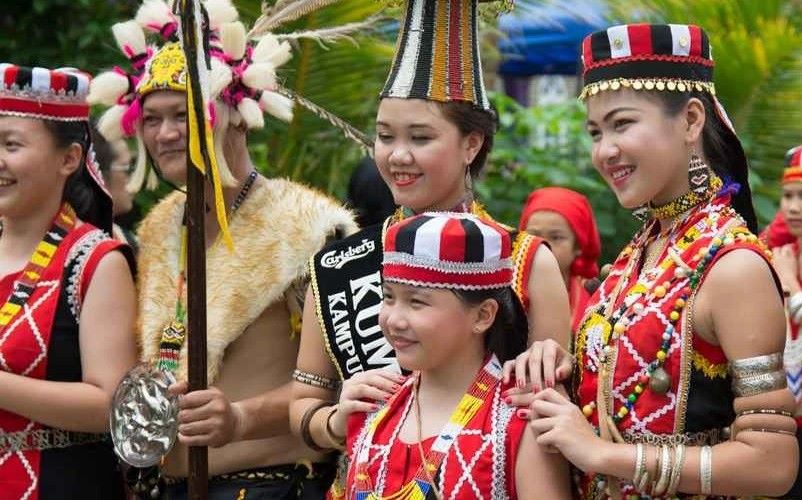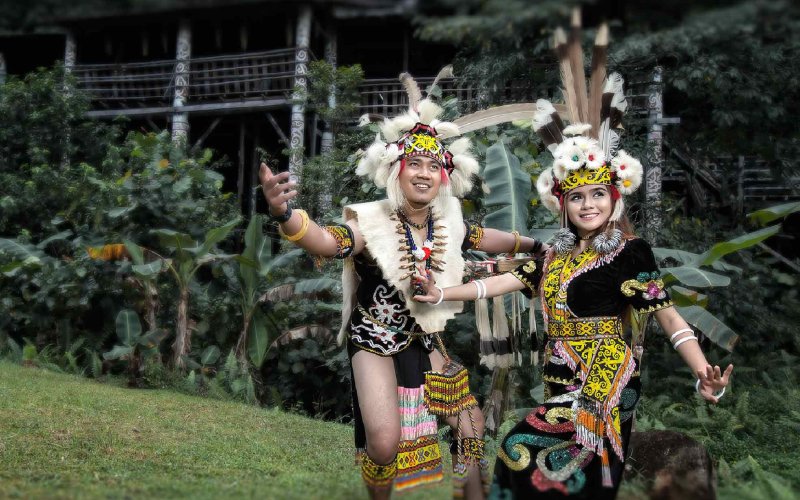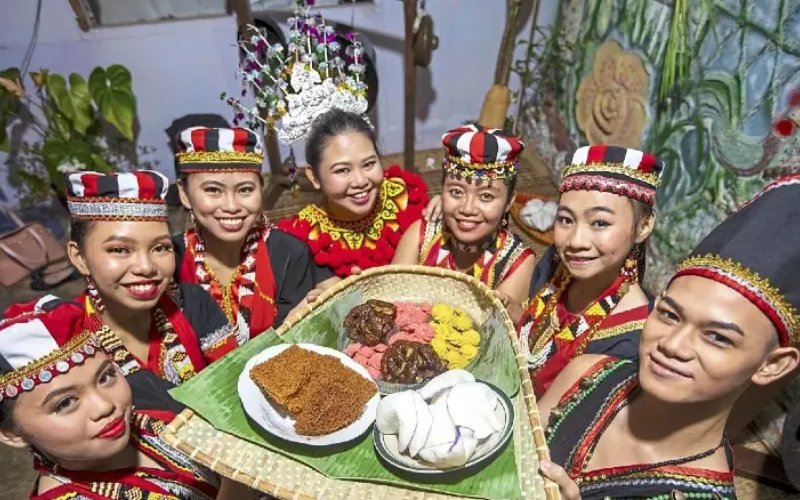If you want to experience a destination’s cultural essence, visit it during its festival season. The vitality and traditions of a country and the enthusiasm of people is amazing to witness. For example, Malaysia values the Sarawak Gawai Festival as a grandiose celebration that honours the Dayak community. It is counted among the top Malaysia festivals and events to witness on a Malaysia holiday.
In many ways, Sarawak differs from modern Malaysia thanks to its rich cultural and natural diversity. It has a mix of races and ethnic groups, but the Dayak ethnic group dominates the. The Gawai Festival is an important event for this community. In June, after the rice harvesting season ends, it is celebrated grandly as a harvesting festival.
Significance of Sarawak Gawai Festival
Celebrated annually on the 1st of June, the Sarawak Gawai Festival is mainly held by the Dayak community in Malaysia. This festival is celebrated throughout the Dayak community of Malaysia as a harvest festival, showing gratitude for successful rice harvesting. It portrays a celebration of hope and unity. It is also called Sarawak Day and is a national holiday in the region. This day places a lot of emphasis on relationships and spirituality. People in the community use this day as an opportunity to reconcile past differences and old relationships, and come together to be thankful. They pay tribute to the departed, pray for a good future, and enjoy the harvest celebrations. In the modern era, it is also a time for family members earning a livelihood in faraway lands to come back home and meet their families and enjoy the celebrations together.
Sarawak Gawai Festival Celebrations – An Overview
The Sarawak Gawai Festival Rituals
Around a week before the festivities begin, the region will be buzzing with activity. It is common for locals to spend their free time erecting a tree of life in the middle of the longhouse gallery, cleaning the homes, and decorating them with traditionally woven cloth and other handicrafts. Sarawak Gawai is a festival filled with rituals and customs aimed at bringing prosperity and positivity. The celebration begins the evening before with a ritual known as Muai Antu Rua that purifies the community of negativity.

Image Source: bohemiantraveler.com
Usually, two men carry a basket from house to house collecting unwanted items and throwing them away to ward off negativity. Then, a procession is performed to invite good spirits and wish everyone in the local dialect – ‘Gayu Guru, Gerai Nyamai, Senang Lantang Nguan Menua’ which means wishing long life, health, and prosperity.
Sarawak Gawai Festival Dressing
The local dress code during the festival is called ‘Ngepan’. Traditionally, men wear animal skins, loincloths, feather headgear and crowns, and accessorize with beaded necklaces and tattoos that represent their ethnicity and experiences. The women wear drapes made of handmade cloth around their waists, a colorful corset, and tribal jewellery.
Sarawak Gawai Festival Dance

The festivities of 31 May include gendang rayah, a ritual music performance followed by a miring – an elaborate ceremony where the chief expresses gratitude on behalf of the community to the Gods for the productive harvest and solicits their blessings for the future. The feast and entertainment for the evening begin here. To bring in the Gawai festival, a gong is rung at midnight and everyone raises a toast with tuak for a long and prosperous life. From then on, the celebration only gets grander. The Ngajat dance form is a premier traditional dance performed by men and women together. In addition to dances, sword dances, martial arts performances and exhibits of various stunts and warrior manoeuvres are also performed during the performance. There are various other games and sports that the community engages in, such as arm wrestling and log pulling.
Sarawak Gawai Festival food

The preparations begin with the traditional brewing of tuak, or rice wine, which is made from glutinous rice combined with homemade yeast. A rich feast of traditional dishes cooked on traditional earthenware adorns the palette on the festival day. It consists of homemade penganas, rice flour, and coconut milk cake, ‘Pansoh-meat cooked in bamboo logs, rice cooked in bamboo logs, and freshly plucked vegetables and local meat served over traditionally brewed tuak. Gawai Festival’s main dish features rice as one of its primary ingredients.
Interesting Things to Explore During the Sarawak Gawai Festival
The Gawai Festival is a profound cultural encounter rather than merely a celebration. Here are a few special experiences that are only available in Sarawak during this season.
- Take in or participate in the captivating festival highlight, the traditional Ngajat dance, which is done to the beat of drums and gongs while dressed in vibrant costumes.
- Listen to the sound of bamboo cannons being fired, a long-standing custom used to commemorate Gawai joy. It is exciting and celebratory.
- See how the traditional rice wine, tuak, is prepared and distributed among neighbors as an act of hospitality and friendship.
- A lot of longhouses welcome visitors during Gawai. Unlike any other time of year, you will experience food, laughing, storytelling, and a sense of community.
- The march of Iban, Bidayuh, and other indigenous communities in their best ceremonial clothing is a must-see for learning about their culture and taking pictures.
- During the festival, many local artists provide hands-on sessions. You to try your hand at traditional Sarawak crafts like basket weaving, beadwork, or blowpipe demonstrations.
Tips on How to Have Fun in Sarawak Gawai Festival
If you going to Sarawak to see the Gawai Festival, here are some useful pointers to ensure a pleasurable experience.
- Plan as early as possible for travel and lodging to Sarawak. Accommodations and flights tend to fill up rapidly during Gawai season, which is often late May to early June.
- There is no strict dress code to attend the Gawai Festival. It is however considered polite to wear modest clothing, particularly when attending traditional ceremonies or touring longhouses.
- Bring a little gift, like fruits, candies, or snacks if you are invited into a longhouse, an Iban traditional dwelling.
- Gawai cuisine is rich and savory. Be sure to try dishes like tuak which is rice wine and pansuh, a bamboo-cooked beef.
- Consume alcohol responsibly in public places.
- Take part in ethnic dances and rituals.
- Always listen to the advice of the locals.
- Take permission before taking pictures of ceremonies or individuals.
- The weather can be hot and muggy, particularly in rural areas or during outdoor community gatherings.
Conclusion
During the Sarawak Gawai Festival, one can experience the true essence of Malaysia, which is unlike the modern Malaysia we all know. The festival here is deeply ingrained in each household and you can experience the genuine enthusiasm, humility, and gracious hospitality of the lesser-known communities in Malaysia. The customs and traditions passed down through generations are celebrated in the villages with vigour and merriment loaded with lots of food, singing, dancing, and drinking to usher in the new farming season.
This significant Malaysian festival is held at Skrant River, Batang Ai, and Lemanak River and those who would like to witness authentic Malaysia should definitely include Sarawak in their Malaysia trip itinerary. Being familiar with Malaysian festivals and events is as important as being knowledgeable about visas and other aspects of travel. Going through a complete travel requirements guide to Malaysia is a great way to be sure you are covered for your trip. Visiting Malaysia during festivals is an excellent way to experience Malaysian culture without being influenced by modern life.
